
La Earthcache / The Earthcache
► Site d'observation
Le Lac Bleu de Meygal occupe une ancienne carrière d'où était extraite la pierre chantante, une roche débitée sur place en lauzes destinées à la couverture des maison.
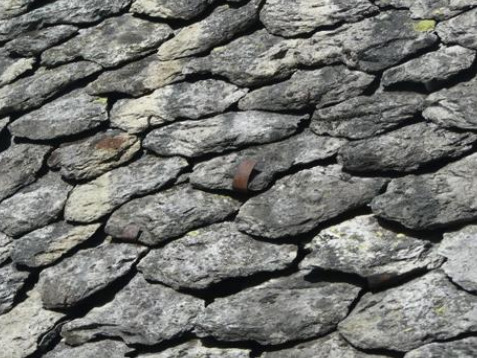
Cet endroit, libre d'accès et aménagé en zone de loisirs, est désormais un lieu privilégié pour étudier cette roche volcanique acide particulière, la phonolite.
► Contexte géologique local et formation
L'étude du nord de la région de Champclause montre que le massif du Meygal, dominé par le suc de Testavoyre, est formé d'une roche issue d'une lave acide, la phonolite.

Le massif du Meygal fait partie du reste d'un système volcanique péléen mis en place il y a 12 Ma.
A la fin de l’ère tertiaire, la formation des Alpes a provoqué le soulèvement et la fissuration du vieux socle hercynien, permettant le passage d'un magma qui est remonté en plusieurs paliers pour se figer très rapidement en surface.
La lave des volcans péléens, très visqueuse et peu riche en gaz, remonte lentement à la verticale depuis la chambre magmatique.
Elle est acide, pâteuse, émise à des températures entre 700 et 800°C.
Arrivée en surface, cette lave très visqueuse édifie des dômes particuliers en forme de pains de sucre qu'on appelle localement un suc. Un des exemples le plus célèbre est le Mont Gerbier des Joncs.
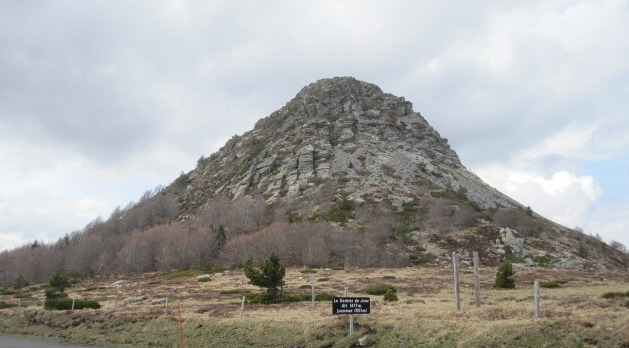
► La phonolite, une roche chantante
Le terme phonolite signifie "pierre sonore", parfois traduit par "pierre qui chante" car des dalles frappées émettent un son clair.
La phonolite est une roche magmatique volcanique massive, de couleur grise, dont la teneur en silice est importante (entre 50 et 60% du poids) et la teneur en alcalin très forte.
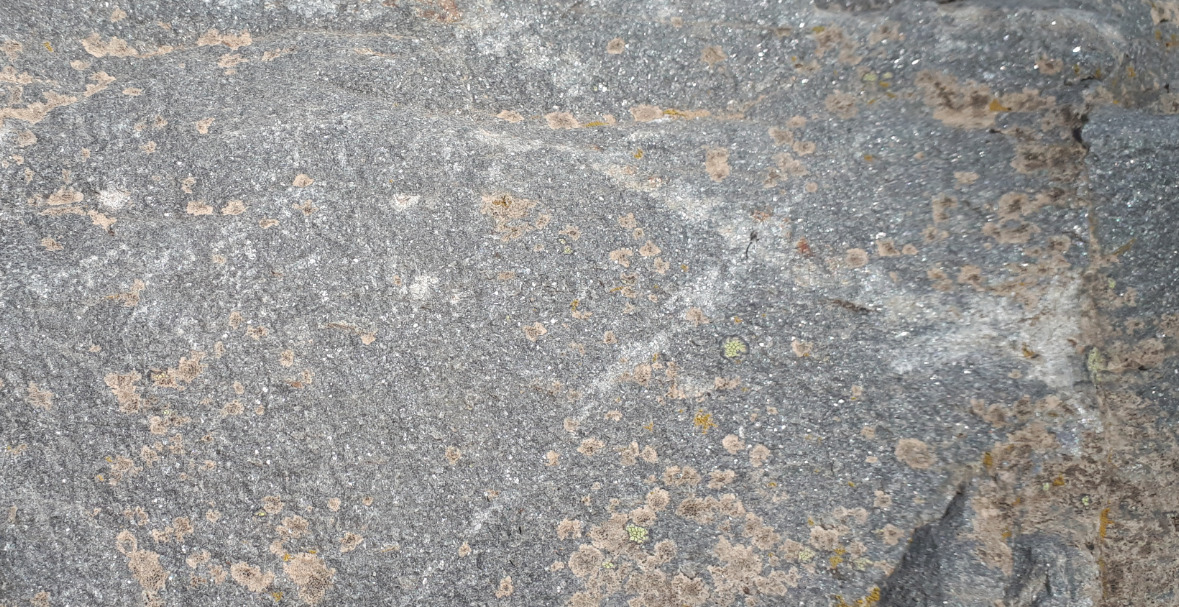
Elle possède une structure microlithique fluidale, composée de feldspaths alcalins (sanidines très brillantes au soleil), de feldspathoïdes et d'une pâte de verre peu abondante, mais jamais de quartz.
En raison de sa forte viscosité, la phonolite s'épanche lentement de sorte que les cristaux de feldspath s'orientent en lignes globalement parallèles dans le sens de l'écoulement au sein d'un verre amorphe, favorisant le débit en plaquettes du fait de sa cassure esquilleuse.
D'un point de vue global, la phonolite peut être vu comme un mille-feuilles de lauzes (feuilles de roche bien plates et plus ou moins épaisses). Ces propriétés explique son exploitation.
Cette roche gris-vert s'enveloppe d'une patine blanchâtre par altération.
Elle peut également prendre une teinte couleur rouille quand les minéraux de fer contenus dans la roche sont oxydés en Fe3+ au contact de l'oxygène de l'atmosphère et de l'eau.
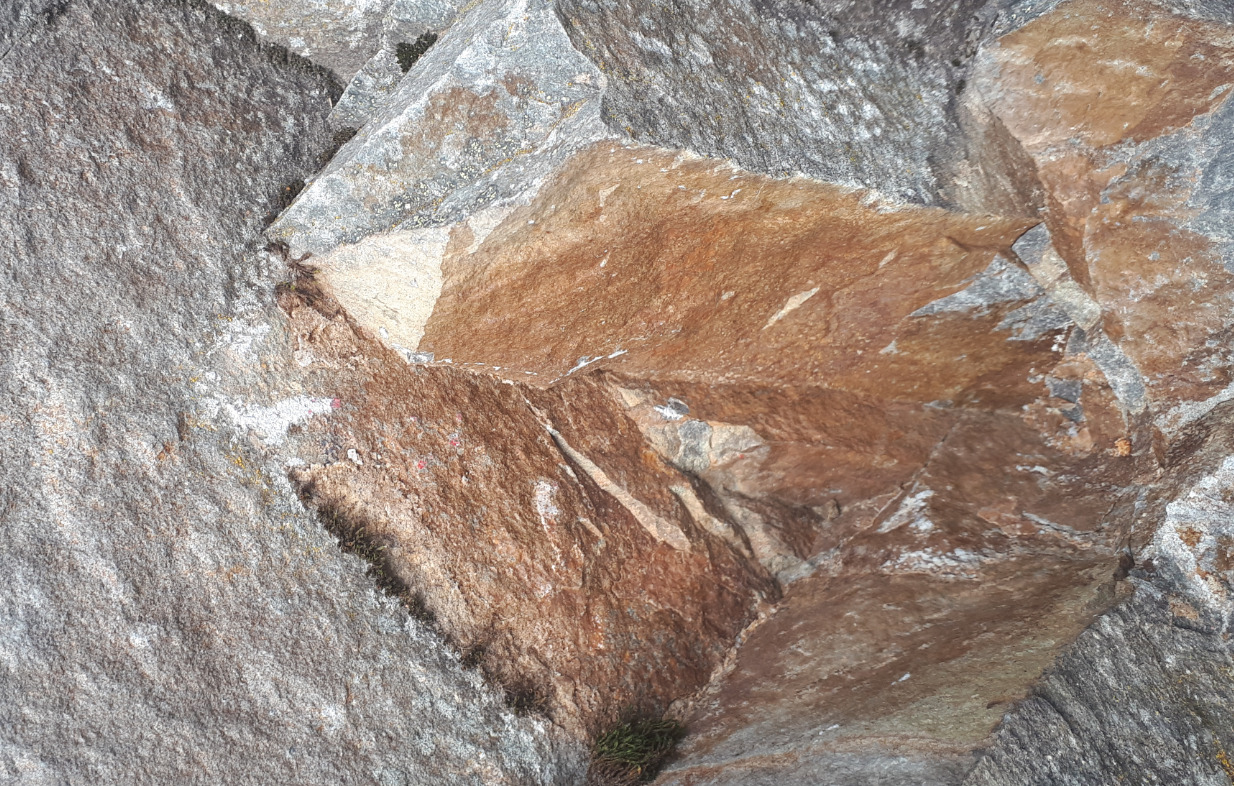
Les propriétés de cette roche, notamment sa richesse en silice, sont responsables de la couleur particulière de ce lac.
En effet, sa couleur est liée, d'une part à l'absorption de la lumière par la profondeur, en commençant par les longueurs d'ondes les plus grandes (rouge, jaune...) et d'autre par à la diffusion puis à la re-émission des ondes de courte longueur d'onde comme le bleu par des microparticules de silice en suspension provenant de l'altération du verre de la phonolite.
► Observation site
The Blue Lake of Meygal occupies an old quarry from which was extracted the singing stone, a rock cut on the spot in slate intended for the roofing of the houses.
This place, free to access and set up as a leisure area, is now a privileged place to study this particular acidic volcanic rock, the phonolite.
► Local geological context and formation
The study of the north of the Champclause region shows that the Meygal massif, dominated by the juice of Testavoyre, is formed by a rock from an acid lava, the phonolite.
The Meygal massif is part of the rest of a Pelean volcanic system set up 12 Ma ago.
At the end of the tertiary era, the formation of the Alps caused the old Hercynian basement to rise and crack, allowing the passage of a magma which rose in several stages to freeze very quickly on the surface.
The lava from Pelean volcanoes, very viscous and not very rich in gas, slowly rises vertically from the magma chamber.
It is acidic, pasty, emitted at temperatures between 700 and 800 ° C.
When it reaches the surface, this very viscous lava builds up special domes in the form of sugar loaves, locally called a juice. One of the most famous examples is Mont Gerbier des Joncs.
► Phonolite, a singing rock
The term phonolite means "sound stone", sometimes translated as "stone that sings" because struck tiles emit a clear sound.
Phonolite is a massive volcanic magmatic rock, gray in color, with a high silica content (between 50 and 60% by weight) and a very strong alkaline content.
It has a fluid microlithic structure, composed of alkaline feldspar (sanidines very bright in the sun), feldspathoids and a scanty glass paste, but never quartz.
Due to its high viscosity, the phonolite spills slowly so that the feldspar crystals orient themselves in generally parallel lines in the direction of flow within an amorphous glass, favoring the platelet flow rate due to its splinter break.
From a global point of view, the phonolite can be seen as a mille-feuille of slate (very flat and more or less thick sheets of rock). These properties explain its operation.
This gray-green rock is enveloped in a whitish patina by weathering.
It can also take on a rusty color when the iron minerals contained in the rock are oxidized to Fe3 + in contact with atmospheric oxygen and water.
The properties of this rock, notably its richness in silica, are responsible for the particular color of this lake.
Indeed, its color is linked, on the one hand to the absorption of light by the depth, starting with the longest wavelengths (red, yellow ...) and on the other hand to the diffusion then the re-emission of short wavelength waves like blue by microparticles of silica in suspension originating from the alteration of the phonolite glass.
► Sources bibliographiques / Bibliographical sources
Les Questions / The Questions
La lecture attentive du descriptif de la cache, ainsi qu'une observation des éléments de terrain et un peu de déduction sont normalement suffisants pour répondre aux questions de cette EarthCache.
A careful reading of the description of the cache, as well as observation of terrain features and some deduction is usually sufficient to answer questions of this EarthCache.
Questions pour valider :"Les Pierres Chantantes du Lac Bleu"
Questions to validate: "The singing stones of Blue Lake"
- Question 0 : Prenez une photo en Noire et Blanc de vous ou d'un élément vous identifiant avec le Lac Bleu en arrière-plan.
Cette photo devra au choix nous être transmise avec les réponses ou être ajoutée à votre log.
-Question 0 : Take a black and white photo of yourself or something identifying you with the Blue Lake in the background.
This photo must either be sent to us with the answers or added to your log.
Point 1 : N 45° 02.221 E 004° 09.251
Entre les gradins et le bord du lac, vous avez un affleurement de roches au sol (zone rouge de la photo WP1).
Between the bleachers and the edge of the lake, you have an outcrop of rocks on the ground (red zone of photo WP1).
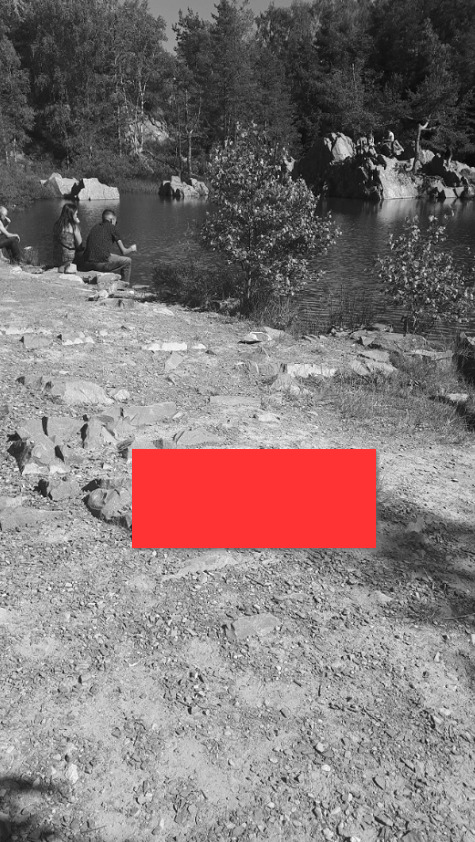
- Question 1 : Décrire la roche (couleur, texture, dureté). Caressez cette roche. Peut-on la qualifier de grenue ? Y observez-vous des traces de vacuoles, comme c'est généralement le cas pour les roches volcaniques ? Pourquoi ?
- Question 1 : Describe the rock (color, texture, hardness). Pet this rock. Can we qualify it as grainy? Do you observe traces of vacuoles there, as is generally the case for volcanic rocks? Why ?
- Question 2 : Observer au soleil ou avec une lampe la face la plus lisse du bloc de roche orientée Nord-Ouest (qui regarde les gradins). Que voyez vous en évidence ? De quoi s'agit-il ?
- Question 2 : Observe in the sun or with a lamp the smoothest face of the rock block facing North-West (which looks at the bleachers). What do you see in evidence? What is it about ?
Point 2 : N 45° 02.209 E 004° 09.290
Vous voici devant un affleurement ; rejoignez le zone bleue en hauteur (voir photo WP2).
Here you are in front of an outcrop; join the blue zone in height (see photo WP2).
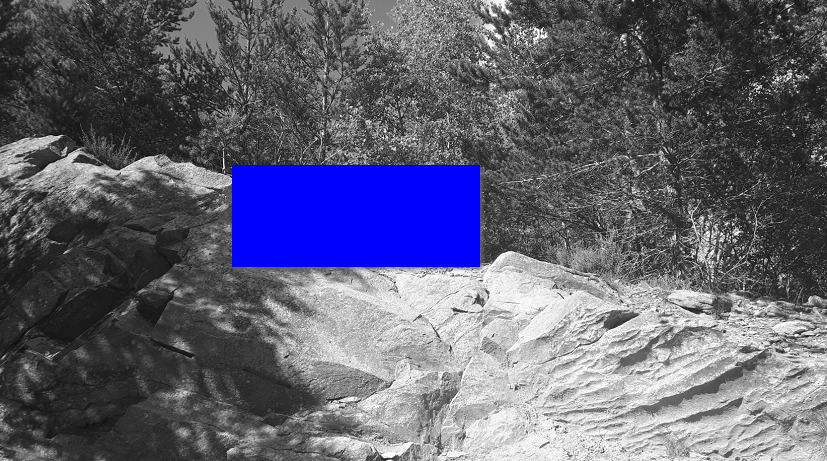
- Question 3 : Quelle est la couleur des blocs sous la zone bleue ? Quelle en est l'origine ?
- Question 3 : What is the color of the blocks under the blue area? What is its origin ?
- Question 4 : Cherche un petit bloc de phonolite large et peu épais et taper le avec un morceau de bois dur. Que pouvez-vous entendre ? Cette roche porte t-elle bien son nom ?
- Question 4 : Look for a small block of wide and thin phonolite and tap it with a piece of hard wood. What can you hear? Is this rock aptly named?
Point 3 : N 45° 02.200 E 004° 09.254
Vous voici au bord de l'eau sur une avancée s'enfonçant dans le lac.
Here you are at the edge of the water on a projection sinking into the lake.
- Question 5 : Quelle est la forme du débit des blocs de roches au bord de l'eau et dans l'eau peu profonde ? Quelle propriété physico-chimique favorise cette forme de débit ?
- Question 5 : What is the shape of the flow of rock blocks at the water's edge and in shallow water? What physicochemical property favors this form of flow?
- Question 6 : De cette position surélevée, quelle est la couleur de l'eau du lac ? Citez le phénomène géologique à l'origine de cette couleur si particulière.
- Question 6 : What is the color of the lake water from this elevated position? Cite the geological phenomenon at the origin of this particular color.
Vous pouvez vous loguer sans attendre notre confirmation,
mais vous devez nous envoyer les réponses en même temps soit par mail via notre profil (
fafahakkai), soit via la messagerie geocaching.com (Message Center).
S'il y a des problèmes avec vos réponses nous vous en ferons part.
Les logs enregistrés sans réponses et la photo seront supprimés.
You can log this cache without waiting for our confirmation, but you must send us the answers at the same time, by e-mail via our profile (fafahakkai) or by the system of Message Center of geocaching.com.
If there is a problem with your answers we will notify you. The logs recorded without answers and the photo will be deleted.
Rappel concernant les « Earthcaches »: Il n'y a pas de conteneur à rechercher ni de logbook à renseigner. Il suffit de se rendre sur les lieux, de répondre aux questions ci-dessus et de nous renvoyer les réponses.
Reminder concerning "Earthcaches": there is neither a container to look for nor a logbook to sign. One need only go to the location, answer to the differents questions and send us the answers.